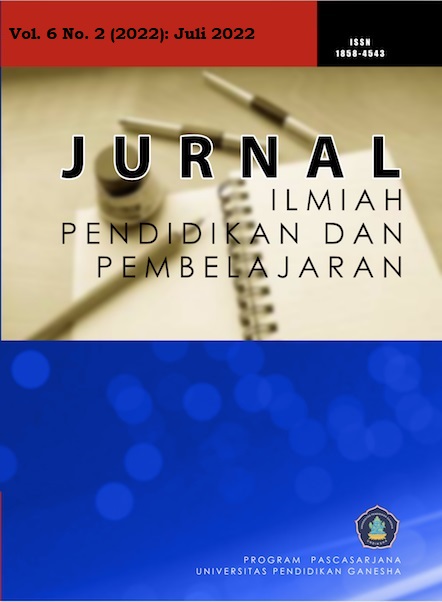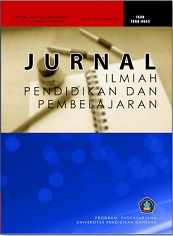Identifying Language Learning Strategies for Children with Communication Disorder in New Normal Era
DOI:
https://doi.org/10.23887/jipp.v6i2.48892Keywords:
Language Learning Strategies, Inclusive Elementary School, Communication DisorderAbstract
Practicing language skills for children with communication disorders is in dire need of optimally tested strategies. This study aims to explore the perceptions of inclusive primary school teachers on the implementation of language learning strategies for children with communication disorders in the New Normal era. Data was collected through a survey of 137 teachers and semi-structured interviews with 24 inclusive primary school teachers. Data analysis used quantitative surveys and thematic analysis of qualitative data. The results of the analysis found four main themes namely, listening skills learning strategies, speaking skills learning strategies, reading skills learning strategies, and writing skills learning strategies. The results of this study indicate that language learning strategies for children with communication disorders vary widely from listening to voices, listening news, writing by dictation, reading pictures, appreciating drama, telling stories, singing, and many more. However, all language skills learning strategies for children with communication disorders will not succeed without the involvement of teachers, parents, and the surrounding community. We all have to realize that following children's development is the most important thing to realize optimal child development. Parents must have quality time and the ability to detect children's growth and development, especially children's language and communication development. This research can also be a reference for future researchers to develop a learning model that is appropriate for children with communication disorders.
References
Aprinawati, I. (2017). Pengaruh Model Pembelajaran Sinektik Terhadap Kemampuan Menulis Puisi Bebas Siswa Sekolah Dasar Negeri 55 Pekanbaru. Jurnal Basicedu, 1(1), 31–44. https://doi.org/10.31004/basicedu.v1i1.159.
Ashman, G., & Snow, P. (2019). Oral Language Competence: How It Relates to Classroom Behavior. American Educator, 43(2), 37–41. https://eric.ed.gov/?id=EJ1218776.
Aydoğan, H., & Akbarov, A. A. (2014). The four basic language skills, whole language & intergrated skill approach in mainstream university classrooms in Turkey. Mediterranean Journal of Social Sciences, 5(9), 672. https://doi.org/10.5901/mjss.2014.v5n9p672.
Aziz, A. (2011). Curriculum Development in Indonesian Education. Curriculum Development in Indonesian Education, 3(2). https://doi.org/10.18860/jt.v0i0.1312.
Braun, V., & Clarke, V. (2006). Qualitative Research in Psychology Using thematic analysis in psychology Using thematic analysis in psychology. Qualitative Research in Psychology, 3(2), 77–101. https://doi.org/10.1191/1478088706qp063oa.
Braun, V., Clarke, V., Boulton, E., Davey, L., & McEvoy, C. (2021). The online survey as a qualitative research tool. International Journal of Social Research Methodology, 24(6), 641–654. https://doi.org/10.1080/13645579.2020.1805550.
Creswell, J. W. (2017). Research design: Qualitative, quantitative, and mixed methods approaches.
Crozier, G., Denzin, N., & Lincoln, Y. (1994). Handbook of Qualitative Research. British Journal of Educational Studies. https://doi.org/10.2307/3121684.
Daǧhan, G., & Akkoyunlu, B. (2014). Bilişim teknolojileri dersinde kullani{dotless}lan performansa dayali{dotless} deǧerlendirme yöntemlerine İlişkin nitel bir çali{dotless}şma. Kuram ve Uygulamada Egitim Bilimleri, 14(1), 333–338. https://doi.org/10.12738/estp.2014.1.2005.
Dewi, R. S., Fahrurrozi, Hasanah, U., & Wahyudi, A. (2020). Reading Interest And Reading Comprehension A Correlational Study in Syarif Hidayatullah State Islamic University, Jakarta. Talent Development & Excellence, 12(1), 241–250. http://repository.uinjkt.ac.id/dspace/handle/123456789/50885.
Dinehart, L. H. (2015). Handwriting in early childhood education: Current research and future implications. Journal of Early Childhood Literacy, 15(1), 97–118. https://doi.org/10.1177/1468798414522825.
Dunst, C. J., Trivette, C. M., & Raab, M. (2014). Everyday child language learning early intervention practices. Infants and Young Children, 27(3), 207–219. https://doi.org/10.1097/IYC.0000000000000015.
Elmahallawi, T. H., & Gabr, T. A. (2021). Children with developmental language disorder : a frequency following response in the noise study ଝ , ଝଝ. Brazilian Journal of Otorhinolaryngology, xxxx. https://doi.org/10.1016/j.bjorl.2021.01.008.
Fitriyani, F., Sumantri, M. S., & Supena, A. (2019). Language development and social emotions in children with speech delay: case study of 9 year olds in elementary school. Jurnal Konseling Dan Pendidikan, 7(1), 23. https://doi.org/10.29210/130600.
Fox, A. V., Dodd, B., & Howard, D. (2002). Risk factors for speech disorders in children. International Journal of Language and Communication Disorders, 37(2), 117–131. https://doi.org/10.1080/13682820110116776.
Hamson Z. (2019). Teori Kritis Theodor Adorno. Preeprint, 1(Communication Theory), 1–15. https://doi.org/10.6084/m9.figshare.11577867.
Hasanah, U. (2021). Implementation of Online Learning for Children with Language Disorder During the COVID-19 Pandemic: A Case Study in Inclusive Primary Schools. Jurnal Kajian Pendidikan Dan Pendidikan Dasar, 11(1). https://doi.org/10.24114/esjpgsd.v11i1.24095.
Huy, N. T. (2015). Problems affecting learning writing skill of grade 11 at Thong Linh high school. Asian Journal of Educational Research, 3(2). https://www.academia.edu/download/40668008/problems-affecting-learning-writing-skill-of-grade-11.pdf.
Irjananta, R. (2018). Students’ Perception on the Implementation of Extensive Reading at English Language Education Department Rama Kusuma Irjananta, S.H. Universitas Muhammadiyah Yogyakarta.
Ismiyati, W. L., & Saputri, T. (2020). Using Wordwall to Improve English Vocabulary Mastery: Systematic Review. Jurnal Pendidikan Dan Pembelajaran, 12(2), 120–131. http://repository.unusa.ac.id/id/eprint/6581.
Karunia, K., Anggraini, R. W., & Hartono, R. (2019). Analyzing Students’ Perception of Speaking Problems and Mispronunciation At English Department UIGM. Jurnal Global Expert, 7(2), 57–63. https://doi.org/10.36982/jge.v7i2.775.
Käsper, M., Uibu, K., & Mikk, J. (2018). Language teaching strategies’ impact on third-grade students’ reading outcomes and reading interest. International Electronic Journal of Elementary Education, 10(5), 601–610. https://doi.org/10.26822/iejee.2018541309.
Kirk, S., Gallagher, J. J., Coleman, M. R., & Anastasiow, N. (2009). Educating exceptional children. Cengage Learning.
Knauf, H. (2018). Learning Stories: An Empirical Analysis of Their Use in Germany. Early Childhood Education Journal, 46(4), 427–434. https://doi.org/10.1007/s10643-017-0863-9.
Kuder, S. J. (2003). Teaching students with language and communication difficulties.
Kuşdemir, Y., & Bulut, P. (2018). The Relationship between Elementary School Students’ Reading Comprehension and Reading Motivation. Journal of Education and Training Studies, 6(12), 97. https://doi.org/10.11114/jets.v6i12.3595.
Lisa, R., Pola, R., Franz, P., & Jessica, M. (2019). Developmental language disorder: Maternal stress level and behavioural difficulties of children with expressive and mixed receptive-expressive DLD. Journal of Communication Disorders, 80(March), 1–10. https://doi.org/10.1016/j.jcomdis.2019.03.006.
Mardiana, E., & Hidayat, N. (2019). The Effect of Extensive Reading on Students’ Reading Achievement Of Senior High School. Kontribusia (Research Dissemination for Community Development), 2(2), 16. https://doi.org/10.30587/kontribusia.v2i2.1004.
Maxwell, J. A., & Reybold, L. E. (2015). Qualitative Research. In International Encyclopedia of the Social & Behavioral Sciences: Second Edition. https://doi.org/10.1016/B978-0-08-097086-8.10558-6.
Noor, M., Yusoff, N. M., & Noor, M. (2016). Improving Process Writing with the Use Authentic Assessment. International Journal of Evaluation and Research in Education, 5(3), 200–204. https://eric.ed.gov/?id=EJ1115393.
Nugrahanto, S., & Zuchdi, D. (2019). Indonesia PISA Result and Impact on The Reading Learning Program in Indonesia. 297(Icille 2018), 373–377. https://doi.org/10.2991/icille-18.2019.77.
Patrikakou, E. N. (2016). Parent Involvement, Technology, and Media: Now What? School Community Journal, 26(2), 9–24. https://eric.ed.gov/?id=EJ1123967.
Rao, P. S. (2019). The Importance of Speaking Skills in English Classrooms. Alford Council of International English & Literature Journal(ACIELJ), 2(2), 18. https://www.researchgate.net/profile/Parupalli-Rao/publication/334283040_THE_IMPORTANCE_OF_SPEAKING_SKILLS_IN_ENGLISH_CLASSROOMS/links/5d21b2db458515c11c18dbf3/THE-IMPORTANCE-OF-SPEAKING-SKILLS-IN-ENGLISH-CLASSROOMS.pdf.
Riden, B., Taylor, J., Lee, D., & Scheeler, M. C. (2018). A Synthesis of the Daily Behavior Report Card Literature from 2007 to 2017. The Journal of Special Education Apprenticeship, 7(1), 3. https://scholarworks.lib.csusb.edu/josea/vol7/iss1/3/.
Riga Zahara. (2018). Penggunaan Media Audio Visual dalam Pembelajaran Menyimak Dongeng di Era Digital. Universitas Perjuangan Tasikmalaya.
Rudd, H., Grove, N., & Pring, T. (2007). Teaching productive sign modifications to children with intellectual disabilities. AAC: Augmentative and Alternative Communication, 23(2), 154–163. https://doi.org/10.1080/07434610601124867.
Sadiku, L. M. (2015). The importance of four skills reading, speaking, writing, listening in a lesson hour. European Journal of Language and Literature, 1(1), 29–31. https://doi.org/10.26417/ejls.v1i1.p29-31.
Sadiku, Lorena Manaj. (2015). The Importance of Four Skills Reading, Speaking, Writing, Listening in a Lesson Hour. European Journal of Language and Literature, 1(1), 29. https://doi.org/10.26417/ejls.v1i1.p29-31.
Sandra, L. A., & Kurniawati, L. A. (2020). Differentiated instructions in teaching English for students with autism spectrum disorder. Jet Adi Buana, 5(01), 41–53. https://doi.org/10.36456/jet.v5.n01.2020.2274.
Schachter, R. E., Spear, C. F., Piasta, S. B., Justice, L. M., & Logan, J. A. R. (2016). Early childhood educators’ knowledge, beliefs, education, experiences, and children’s language- and literacy-learning opportunities: What is the connection? Early Childhood Research Quarterly, 36, 281–294. https://doi.org/10.1016/j.ecresq.2016.01.008.
Sharma, C., & Puri, S. R. (2020). The importance of four skills in English education. The Genesis, 7(4), 33–36. https://doi.org/10.47211/tg.2020.v07i04.007.
Smieskova, E. (2017). Communication Students’ Skills as a Tool of Development Creativity and Motivation in Geometry. Universal Journal of Educational Research, 5(1), 31–35. https://doi.org/10.13189/ujer.2017.050104.
Srivastava, M., de Boer, A. A., & Pijl, S. J. (2017). Preparing for the inclusive classroom: changing teachers’ attitudes and knowledge. Teacher Development, 21(4), 561–579. https://doi.org/10.1080/13664530.2017.1279681.
Supina. (2018). Four Basic Skills Proficiency Based on Students’ Perception in Hospitality & Tourism Study Program, Bunda Mulia University. Journal of English Language and Culture, 8(2), 128–139. https://doi.org/10.30813/jelc.v8i2.1097.
Thompson, D. R., & Rubenstein, R. N. (2014). Literacy in Language and Mathematics. Journal of Adolescent & Adult Literacy, 58(2), 105–108. https://doi.org/10.1002/jaal.338.
Titarenko, L., & Little, C. B. (2017). International Cross-Cultural Online Learning and Teaching: Effective Tools and Approaches. American Journal of Distance Education, 31(2), 112–127. https://doi.org/10.1080/08923647.2017.1306767.
Torres, F., Fuentes-López, E., Fuente, A., & Sevilla, F. (2020). Identification of the factors associated with the severity of the speech production problems in children with comorbid speech sound disorder and developmental language disorder. Journal of Communication Disorders, 88(June 2019). https://doi.org/10.1016/j.jcomdis.2020.106054.
Wahyuni, T., Suwandi, S., Slamet, S. Y., & Andayani, A. (2019). The Content Of Indonesian Language Syntactic Learning Instrument Based On The Need Analysis Directed To The Indonesian Language And Literature Education Department Students Among The Universities In Surakarta Indonesia. Anatolian Journal of Education, 2(1). https://doi.org/10.29333/aje.2017.211a.
Walet, J. (2011). Differentiating for Struggling Readers and Writers: Improving Motivation and Metacognition through Multisensory Methods & Explicit Strategy Instruction. Journal of the American Academy of Special Education Professionals, 83–91. https://eric.ed.gov/?id=EJ1137150.
Wankoff, L. S., & Cairns, H. S. (2009). Why ambiguity detection is a predictor of early reading skill. Communication Disorders Quarterly, 30(3), 183–192. https://doi.org/10.1177/1525740108324096.
Zulkaida, A., Dewi, M. P., & Prabowo, H. (2005). Metode mengajar dengan menstimulasi otak kiri dan otak kanan. Seminar Nasional PESAT, 96–103. http://repository.gunadarma.ac.id/925/.
Downloads
Published
How to Cite
Issue
Section
License
Copyright (c) 2022 Totok Bintoro, Fahrurrozi, Murni Winarsih

This work is licensed under a Creative Commons Attribution-ShareAlike 4.0 International License.
Authors who publish with the Jurnal Ilmiah Pendidikan dan Pembelajaran (JIPP) agree to the following terms:
- Authors retain copyright and grant the journal the right of first publication with the work simultaneously licensed under a Creative Commons Attribution License (CC BY-SA 4.0) that allows others to share the work with an acknowledgment of the work's authorship and initial publication in this journal.
- Authors are able to enter into separate, additional contractual arrangements for the non-exclusive distribution of the journal's published version of the work (e.g., post it to an institutional repository or publish it in a book), with an acknowledgment of its initial publication in this journal.
- Authors are permitted and encouraged to post their work online (e.g., in institutional repositories or on their website) prior to and during the submission process, as it can lead to productive exchanges, as well as earlier and greater citation of published work. (See The Effect of Open Access)










